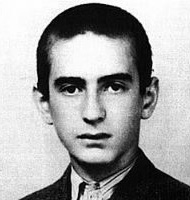#201 Meet Three Shoah Survivors
#201 Who Survived The Shoah and How? Meet Anne Frank, Viktor Frankl, Elie Wiesel
*This lesson is appropriate for students in grade six and older
The Shoah (Hebrew: השואה, HaShoah, “the catastrophe”), was a genocide in which Adolf Hitler‘s Nazi Germany and its collaborators killed about six million Jews. Jewish communities across Europe were shattered. Many of those who survived were determined to leave Europe and start new lives in Israel or the United States. The population shifts brought on by the Holocaust and by Jewish emigration were astounding.
The Jewish population of Europe was about 9.5 million in 1933. In 1950, the Jewish population of Europe was about 3.5 million. In 1933, 60 percent of all Jews lived in Europe. In 1950, most Jews (51 percent) lived in the Americas (North and South combined), while only a third of the world’s Jewish population lived in Europe.
Before the Nazi takeover of power in 1933, Europe had a vibrant and mature Jewish culture. By 1945, most European Jews—two out of every three—had been killed. Most of the surviving remnant of European Jewry decided to leave Europe. Hundreds of thousands established new lives in Israel, the United States, Canada, Australia, Great Britain, South America, and South Africa.
How did people survive? LUCK and GOOD FORTUNE! Some people survived by being hidden by non-Jewish families, some survived the work camps, and others escaped Europe to other countries. After the war, most of the survivors moved to either Israel (135,000) or to North American (80,000). In 2017, there are approximately 10,000 survivors remaining alive in the world.
_______________________________________________________________________________
#1 MEET ANNE FRANK
 Anne Frank, (June 1929 – February or March 1945) was a German-born diarist and writer. She is one of the most discussed Jewish victims of the Holocaust. Her diary, The Diary of a Young Girl, which documents her life in hiding during the German occupation of the Netherlands in World War II, is one of the world’s most widely known books and has been the basis for several plays and films.
Anne Frank, (June 1929 – February or March 1945) was a German-born diarist and writer. She is one of the most discussed Jewish victims of the Holocaust. Her diary, The Diary of a Young Girl, which documents her life in hiding during the German occupation of the Netherlands in World War II, is one of the world’s most widely known books and has been the basis for several plays and films.
_______________________________________________________________________________
#2 MEET VICTOR E. FRANKL
 Dr. Victor Frankl was a psychologist and holocaust survivor. Even after living through the horrors of The Shoah, he emerged very strong and secure. But how? He wrote a famous book after his experience in the camps called, “Man’s Search for Meaning.” Some of famous quotes include: “He who has a WHY to live for can bear almost any HOW.” He also said, “Don’t aim at success – the more you aim at it and make it a target, the more you are going to miss it. For success, like happiness, cannot be pursued; it mus ensue, and it only does so as the unintended side effect of one’s dedication to a cause greater than oneself.”
Dr. Victor Frankl was a psychologist and holocaust survivor. Even after living through the horrors of The Shoah, he emerged very strong and secure. But how? He wrote a famous book after his experience in the camps called, “Man’s Search for Meaning.” Some of famous quotes include: “He who has a WHY to live for can bear almost any HOW.” He also said, “Don’t aim at success – the more you aim at it and make it a target, the more you are going to miss it. For success, like happiness, cannot be pursued; it mus ensue, and it only does so as the unintended side effect of one’s dedication to a cause greater than oneself.”
_______________________________________________________________________________
#3 MEET ELIE WIESEL
 Eliezer “Elie” Wiesel ( September 30, 1928 – July 2, 2016) was a Romanian-born American Jewish writer, professor, political activist, Nobel Laureate and Holocaust survivor. He was the author of 57 books, written mostly in French and English, including Night, a work based on his experiences as a prisoner in the Auschwitz and Buchenwald concentration camps.
Eliezer “Elie” Wiesel ( September 30, 1928 – July 2, 2016) was a Romanian-born American Jewish writer, professor, political activist, Nobel Laureate and Holocaust survivor. He was the author of 57 books, written mostly in French and English, including Night, a work based on his experiences as a prisoner in the Auschwitz and Buchenwald concentration camps.
Along with writing, he was a professor of the humanities at Boston University, which created the Elie Wiesel Center for Jewish Studies in his honor. He was involved with Jewish causes, and helped establish the United States Holocaust Memorial Museum in Washington, D.C. In his political activities he also campaigned for victims of oppression in places like South Africa and Nicaragua and genocide in Sudan. He publicly condemned the 1915 Armenian Genocide and remained a strong defender of human rights during his lifetime.
Wiesel was awarded the Nobel Peace Prize in 1986, at which time the Norwegian Nobel Committee called him a “messenger to mankind,” stating that through his struggle to come to terms with “his own personal experience of total humiliation and of the utter contempt for humanity shown in Hitler‘s death camps”, as well as his “practical work in the cause of peace”, Wiesel had delivered a message “of peace, atonement and human dignity” to humanity. He was a founding board member of the New York Human Rights Foundation and remained active throughout his life.[7][8]
________________________________________________________________________________________
